Top News
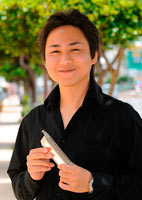
December 17, 2013 Ryukyu Shimpo
Chromatic Harmonica player Sachito Higa, 28, won second place at the category of solo chromatic with a set piece in the World Harmonica Festival 2013 in Germany.
Held once every four years, the festival is the world’s top international contest for harmonica players. It was the second time for Higa to win a prize since he came second in the last festival, held in 2005.
The contest was held from October 30 to November 3. Higa practiced for six months on the set piece music, which was a difficult piece by a 21st-century classical composer. He said, “The judges commented that the sound was beautiful but I couldn’t play how I wanted to because of the distinctive atmosphere of the contest. I would like to interact with people who play different instruments and gain more experience.”
(English translation by T&CT, Hitomi Shinzato and Mark Ealey)
Go to Japanese
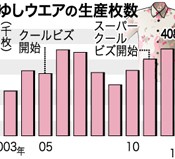
December 20, 2013 Ryukyu Shimpo
The annual production volume of kariyushi shirts has exceeded 400,000 items for the first time. According to the Okinawa Clothing Sewing and Manufacturing Industrial Association, the volume of these shirts shipped from January to November 2013 totaled 408,365. This broke the record of 385,965 set in 2012. The shipping volume from November 2012 to August 2013 was up over the same period last year by 30,000 to about 82,000. The overall shipping volume both inside and outside Okinawa has grown because Japanese major companies have promoted the use of kariyushi shirts.
According to the association, production of kariyushi shirts reached 350,000 in 2006 thanks to a campaign started in 2005 to reduce air-conditioner use by encouraging workers to dress lightly during summer. The number of shirts decreased to about 260,000 in 2009, but then recovered to over 300,000 in 2010.
After the Great East Japan Earthquake, companies promoted a campaign to encourage dressing lightly, leading to an increase in shipping and production volume.
JFE Engineering introduced kariyushi shirts as their work dress from this July. This meant that 3,000 employees in the main office in Yokohama and 12 branches nationwide from Hokkaido to Kyushu, and 12 other companies in the group started using the shirts. They ordered about 10,000 shirts from Okinawan companies in April in an attempt to save energy and improve efficiency.
Production volume of long-sleeved kariyushi shirts has also been increasing. Akihiko Higa, the chief researcher of the Project Support Division of Kaiho-soken said, “So far, long-sleeved shirts have been an untapped market. Momentum will gather if a campaign starts to encourage changing to long-sleeved kariyushi shirts on November 1, the day employees change to winter clothes. Then production of long-sleeved kariyushi shirts will increase further.”
(English translation by T&CT, Lima Tokumori and Mark Ealey)
Go to Japanese
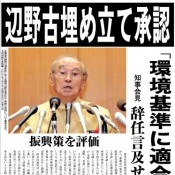
December 27, 2013 Ryukyu Shimpo
Okinawa Governor Hirokazu Nakaima held a press conference at his official residence in Naha at 3:00 p.m. on December 27. He announced that he has approved the government’s application for a landfill at Henoko in preparation for relocating the U.S. Marine Corps Air Station Futenma. Nakaima said, “At this stage the government is taking all the measures it can to protect the environment. I have therefore judged that the application meets the standards set out under the Public Water Body Reclamation Act.” He requested that the people of Okinawa accept this decision.
The governor commented on how his decision was consistent with his election promise to demand that the Futenma base be moved outside the prefecture. Nakaima said, “I still think that moving the facilities at Futenma to existing airfields outside the prefecture is the quickest way to resolve this issue.” He then emphasized that “The government needs to consider all options for relocation outside Okinawa so as to stop operations at Futenma within five years. This is the case whether they go ahead with the Henoko relocation, or if it is a temporary measure.”
The governor said, “The consideration for Okinawa shown by the Abe Cabinet is stronger than that of previous cabinets.” Nakaima indicated that he appreciated the increase in budget for the promotion of economic development in Okinawa. He added that he approved the landfill based on the prime minister’s responses to his requests, including proposed measures to reduce Okinawa’s base burden.
Nakaima stated that he has no intention of resigning to take responsibility for the decision to permit the landfill.
(English translation by T&CT, Mark Ealey)
Click to enlarge (PDF file 3. 94MB)
Go to Japanese
December 25, 2013 Ryukyu Shimpo
Okinawa Governor Hirokazu Nakaima met with Prime Minister Shinzo Abe at Prime Minister’s Official Residence in the afternoon of December 25. The two leaders discussed the application to carry out the landfill at Henoko in preparation for moving U.S. Marine Corps Air Station Futenma.
In response to Nakaima’s requests for a reduction of base burden, Abe stated that the government will start negotiating with the United States towards a new agreement on protecting and surveying the environment inside bases. Nakaima added that he was impressed with the government’s suggestions. He said, “What they have offered is surprising. I am grateful for that.” He said that he would officially decide whether or not to approve the application for the Henoko landfill on December 27.
In the meeting, Abe said that the government plans to transfer half of the training flights of the MV-22 Osprey deployed to the Futenma base to other parts of Japan. Abe also said that the government will set up a team within the Ministry of Defense to consider moving forward the return of the Makiminato Service Area to within seven years.
Abe said, “The Japanese government will focus its efforts on developing the Okinawan economy and reducing the prefecture’s burden of bases.” Nakaima said, “I accept what the prime minister has said and will now decide whether or not to approve the application.”
After the meeting, Nakaima spoke to the press, saying, “The Japanese government worked quite quickly to meet our demands. I think that it will be a good new year.”
When talking to the media, Abe said, “The Japanese government will do all it can. We are determined to produce a solid result.”
The governor will return to Okinawa in the evening of December 25. After discussing the matter with officials in the prefectural government, he will officially decide whether or not to approve the application.
(English translation by T&CT, Mark Ealey)
Go to Japanese
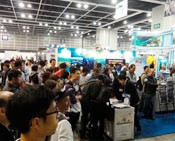
December 19, 2013 Wu Li Jun of Ryukyu Shimpo
The number of foreign tourists who visit Okinawa for diving is increasing. According to a survey carried out by the Okinawa Convention and Visitors Bureau (OCVB), 5,177 foreign visitors experienced diving in the prefecture’s waters between January to September 2013. This was greater than the 3,691 who dived in Okinawa last year.
A breakdown of tourists coming for diving indicates that four locations in Asia accounted for more than 70 percent of the total. The number of visitors from Hong Kong was 1,406, twice that of last year. The number from Taiwan increased 1.9 times to 898, from Korea increasing by 1.3 times to 908, and from China increased by 1.4 times to 526. Tourists from countries such as Indonesia, Australia, Britain and Russia also visited Okinawa.
In order to attract foreign divers, since 2012 the Okinawa Prefectural Government and the OCVB have been actively taking part in diving exhibitions in Asia, the United States and Europe.
They have taken part 12 times in exhibitions such as the biggest diving tour expo in the Asia-Pacific region, the Diving Resort Travel Expo, and in the Paris International Dive Show. The latter event normally attracts about 50,000 visitors. From June 20 to 22 next year, they will hold the first Diving Resort Travel Expo in Okinawa at the Convention Center in Ginowan. An OCVB spokesperson said, “The number of foreign visitors who come to Okinawa for diving will definitely increase. We hope that more than 10,000 visitors will come in the next year.”
(English translation by T&CT, Mark Ealey)
Go to Japanese
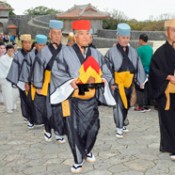
December 21, 2013 Ryukyu Shimpo
The Shuri Tonokura Community Association held a Nubi dedicatory ceremony at Shuri Castle on December 22. In this ceremony, people traditionally took water from the Heduukka River in Kunigami and the Takushi Hija River in Urasoe and presented it to the Ryukyu Kingdom’s authorities in Shuri.
On this occasion, about 40 people, including local residents in officials’ costumes, noro or female oracles and female officials, paraded from the Shuri Community Center to the castle. There, the “officials” presented the water to the Aumushirare or high-ranking female oracle and prayed for a bountiful harvest.
Seventy-five-year-old Setsuko Funakoshi, who served as the Aumushirare, said, “I prayed for next year to bring health and prosperity to the Okinawan people.”
(English translation by T&CT, Mark Ealey)
Go to Japanese
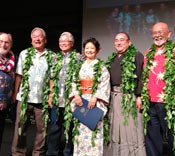
December 9, 2013 Chikako Nago of Ryukyu Shimpo
On November 3 at the Sheraton Waikiki Hotel, the Hawaii United Okinawa Association held a ceremony for the Yujiri Legacy Awards 2013. This event recognizes individuals who have contributed to the well-being of Hawaiian society and provided outstanding service in Hawaii’s Okinawan community. This year is the fifth time it has been held since 2003.
More than 400 people, including Governor Neil Abercrombie and Mayor of Honolulu Kirk Caldwell gathered to celebrate the event. Those honored with awards were introduced with short video clips about their lives and contributions, with performances by their families and friends also adding to the ceremony.
President of the association, George Bartels, said that its mission is to promote, pass on, and preserve Okinawan culture. He went on to say that he thanked all those who received awards for their outstanding contributions and continued support of the association.
The award winners contributed to preserving and passing on Okinawan culture by manifesting the chimugukuru and yuimaru spirit inherited from their ancestors. The six award winners are as follows:
Doris Ching, (Yonabaru Chojin Kai) contributed to higher education at universities in Hawaii, Guam, and California.
Charles Toguchi (Ginoza Sonjin Kai) contributed as an educator and politician to Hawaii’s public schools to the implementation of Hawaiian language education.
Jackson Nakasone (Shuri Naha Club) contributed as a commercial real estate agent to building the Hawaii Okinawa Center and Plaza.
Cheryl Yoshie Nakasone (Goeku son) is a master dance instructor and director of Jimpu Kai USA and lecturer at the University of Hawaii.
Grant “Sandaa” Murata (Kanegusuku Sonjin Kai) is a master sanshin instructor and director of the Afuso Ryu Gensei Kai Hawaii Chapter. He has contributed to training instructors.
Henry Isara (Kochinda Chojin Kai) has worked as an adviser for entertainment events. He has contributed to presenting Okinawan culture as a community leader and producer of the Hawaii Okinawa Today TV show.
(English translation by T&CT, Megumi Chibana and Mark Ealey)
Go to Japanese
December 19, 2013 Ryukyu Shimpo
On December 18, the Yaeyama Office of the Okinawa Prefectural Government announced the figures for the estimated number of inbound tourists to the Yaeyama Islands. From January to October it was up to 810,000 people, a 32.5 percent increase over the same period the previous year, and a new high for a year. This was achieved in just ten months.
The Yaeyama Visitors Bureau was aiming for 800,000 inbound tourists this year, but the target was exceeded two months before the end of the year. They hope that the final figure will exceed 900,000.
According to the office, this is the first time in the history of the Yaeyama tourism that the annual number of inbound tourists has exceeded 800,000. The previous record was 787,502, set in 2007.
The opening of the New Ishigaki Airport on March 7 stimulated tourism to Yaeyama, with inbound numbers breaking previous records each month since April. In July the number of tourists exceeded 100,000 for the first time and then went beyond that figure in August and September.
Despite typhoons causing cancellations of flights in October, in comparison to the same period the previous year the number of tourists was still up by 50.2 percent to 83,648.
The commencement of services by low-cost carriers due to the runway extension, the increase in the number of direct flights to the main islands of Japan and charter flights to overseas destinations all contributed to the increase in the number of inbound tourists.
(English translation by T&CT, Mark Ealey)
Go to Japanese
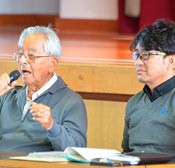
December 18, 2013 Ryukyu Shimpo
Hawaiian resident 90-year-old Takejiro Higa was born in Hawaii and raised in Okinawa from the age of two-years-old. After returning to Hawaii when he was 16-years-old Higa joined the US military and served in the Battle of Okinawa. On December 4, he visited his old school of Kitanakagusuku Elementary School where he spoke to the pupils.
After the Pacific War began, Higa joined the U.S. military, serving in the Battle of Leyte Gulf in the Philippines and the Battle of Okinawa.
Higa served in the US Military Intelligence Service as an interpreter. He told the children about how during the Battle of Okinawa he used both Uchinaguchi (Okinawan language) and Japanese to persuade many Okinawans hiding in caves to surrender. Higa talked about persuading locals hiding in a cave near Nodake in Ginowan to come out and give themselves up. Higa said, “The Japanese military gave them grenades to use to kill themselves.”
After the war, Higa met a woman who was hiding in that cave. Needless to say, she was very grateful for what he did. When she heard Higa speaking Uchinaguchi, she understood that there was an Okinawan outside the cave, and went outside. Higa said, “I was able to save some Okinawans by speaking Uchinaguchi.”
“There is nothing as stupid as war. I want all of you to study hard and work for peace,” said Higa to the children.
He returned to Hawaii on December 5, but Kitanakagusuku Village plans to invite him again to deliver a lecture sometime between June and August next year.
(English translation by T&CT, Mark Ealey)
Go to Japanese
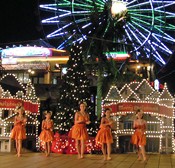
December 13, 2013 Ryukyu Shimpo
Night-time illumination has started at the American Village in Mihama, Chatan. It will run until the end of February 2014.
Visitors can enjoy the decorations during the day and a spot for taking photographs has been set up in front of the Ferris wheel. The opening ceremony attracted many people who enjoyed an ocarina performance and a hula dance show (see photograph).
(English translation by T&CT, Hitomi Shinzato and Mark Ealey)
Go to Japanese
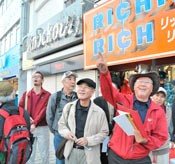
December 12, 2013 Ryukyu Shimpo
From December 14 the Okinawa Machimaai Council Committee will kick off sightseeing tour programs that allow tourists to experience new attractions throughout the prefecture. On December 6, at Koza Gate Street, the Koza Information Center of the Okinawa City Tourism Association held a pre-launch tour of programs for tour guides. The guides went around the city and through billboards came to understand Koza’s turbulent history.
Sadao Oshiro, the president of Sign Okinawa, a billboard company based in Okinawa City, led the tour through streets that prospered near military bases during the post-war period. He pointed out the oldest neon sign, which dates back to the 1960s.
Oshiro said, “Neon signs appeared in Koza in the late 1950s, earlier than in other regions of Okinawa. They reflect the richness of the area’s postwar history.” About 20 guides took part in the tour, walking through the city looking at the English billboards and signs and preparing for when they actually guide tours themselves.
Machimaai provides almost 100 sightseeing and experience-based tour options. It works with Champuru Expo of central and northern Okinawa and the Nambu Zembu Expo of towns and villages in the southern part of Okinawa. It will run until the end of February. Participants can tour towns, ruins and nature spots all around the prefecture, enjoying Okinawan culture, traditional arts and cuisine.
For further details, call the Okinawa Machimaai Council Committee on 098 (987) 960.
(English translation by T&CT, Lima Tokumori and Mark Ealey)
Go to Japanese









 Webcam(Kokusai Street)
Webcam(Kokusai Street)


